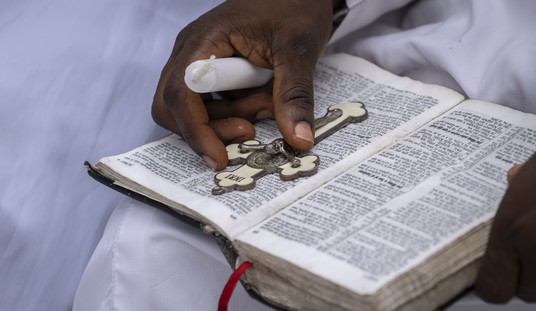In a previous article for PJ Media, “Is Poetry Really Dead?”, I came to the conclusion that it may not be dead but is certainly moribund. The question of poetry’s relevance and quality is a perennial debate — see Joseph Epstein’s controversial 1988 Commentary essay “Who Killed Poetry?” and Dana Gioia’s 1991 Atlantic riposte “Can Poetry Matter?” — yet never more apt than at the present moment. I argued that over the last century, poetic inspiration had been gradually replaced by theories of poetry, one after another cascading into literary prestige. As a result, the poetry being written became largely programmatic, poetic language tending to be either didactic or disruptive, boring or incomprehensible — one of the reasons (among others) that the ancient art has fallen on evil times. Today it is virtually unrecognizable.
A case in point signifying the decay of poetry is the recent Instapoetry craze. Though its volume of sales is through the roof, it bears not the slightest relation to poetry, whether in the traditional or common understanding of the word. It is powered by a multitude of callow phenoms known as Instapoets, who are remarkably adept at manipulating social media and are virtual whizzes at self-promotion and marketing strategies. They congregate on Twitter, Pinterest, Facebook, Tumblr and Instagram, enjoying a massive fan base, sold-out performances and appearances on the late-night talk show circuit.
Writing in BookNet Canada, Kira Harkonen exultantly reports that Instapoets “have completely knocked all literary classics” from their perches on the bookstore shelves. “Homer, the Beowulf poet, Rumi, John Milton, and Dante — all poets who have been celebrated and studied by scholars for hundreds of years — have been bested by the powers of Instagram.” This is apparently an indication of inherent significance and poetic caliber. Assuming such a criterion, Cleo Wade is a superior poet to James Merrill. After all, Heart Talk: Poetic Wisdom for a Better Life has outsold The Changing Light at Sandover by a wide margin.
Jessica Wong writing on the CBC website clearly agrees with the army of Instafans who view Instapoets as “trailblazers stretching boundaries — in form, subject matter and distribution.” They are bucking a literary establishment that “doesn’t have a great track record for championing the work of women, people of colour or young people.”
This is utter nonsense, of course, a sign of ideologically inspired ignorance. Young poets need time to acquire something of import to say and to develop the verbal and technical skills with which to say it. There are very few teenage Rimbauds or Chattertons around to set the literary world on its ears. As for women and poets of color, had I the space I could affix reams of pages crammed with names of so-called minority and marginalized poets, who are routinely eulogized and may actually constitute a majority. Consider this December 26, 2018m article from BuzzFeed featuring ten poets recommending their favorite collections; all ten are what are called marginalized or minority: people of color, women and one white male who is gay. ‘Nuff said.
In her promotion of Instapoetry, Wong contends: “After decades on a downward trajectory, poetry has been enjoying a renaissance thanks to a generation of young, accessible writers breathing new life into the literary form. … Instapoets have inspired passionate fans who say they haven’t ever seen themselves reflected in this way.” If mere accessibility and mawkish catering are factors of choice, then pacifier poetry is obviously the way to go. And why not? It is supremely undemanding, thumbing its nose at Joseph Brodsky’s humble dictum in his On Grief and Reason that the poet’s “only duty is to his language, that is, to write well.” The Instapoets do not write well and have absolutely nothing to say anyway that cannot be found in any self-help book.
As we’ve seen, several of these literary flares have achieved celebrity status and are cheered by vast throngs of admirers wherever they read and perform. We have already met Cleo Wade (aka “The Millennial Oprah”), who writes mantra-like dollops such as:
it’s only natural
Of course
I’ve changed
darling…
I’ve grown
A rather odd fellow who goes by the name of Atticus wears a Guy Fawkes mask, as goofy and unoriginal as the drivel he spouts. Check out Warsan Shire or r.v. Sin or Yrsa Daley-Ward or Lang Leav and weep. Nayyirah Waheed, with over 600,000 followers on Instagram, has graced us with little gems like:
expect sadness
like
you expect rain.
both,
cleanse you
Another of these cynosures, 19-year-old Harman Kaur, who came to prominence with her self-published Phulkari, felt that the poetry she studied in university was inadequate to her self-reflection. “[A]ll I didn’t see in that literature was myself,” she deposes, rather awkwardly. This begs the question of why one should see oneself reflected in a poem as a mark of poetic value, an attitude that betokens a state of puerile self-satisfaction.
Rather, in genuine poetry one learns about oneself and others, comes to see and understand things about oneself or the world that one did not know or only dimly intuited — and in language that impresses itself indelibly on mind and memory. A poem is not a mirror but a window. Moreover, a good poem is damned hard work, requiring prolonged and dedicated labor. “If William Shakespeare was alive today, he would be on Instagram,” Kaur informs us. One notes immediately how juvenile the sensibility that can imagine Hamlet, The Tempest, The Rape of Lucrece, the Sonnets and the rest of the imperishable and language-making oeuvre hiving off Instagram.
The most conspicuous member of the current klatch of incandescent neophytes is 26-year-old Indo-Canadian Rupi Kaur (no relation to Harman), who has parlayed her fame on social media into an international career, selling millions of copies of her books and attracting nearly two million followers. Writing in The New York Times, Carl Wilson endorses “the advent of a young adult subgenre” that challenges “a privileged-white-male establishment hostile to their interests” (here we go again), signalled by poster girl Kaur who mounts “glamorous shots of herself.” “Glamour always counts,” Wilson instructs us — even if, I would add, competence, erudition and ability do not.
Rupi Kaur is a very modest talent — to put it gently — with extraordinary Internet savvy, having risen to loving notoriety with a menstrual photo display that served as a university project. The album is prefaced with a chunk of pretentious prose characterized by grammatical affectations: Lowercase punctuation, periods instead of commas (an allusion no doubt to her “period” piece) and a jumble of sentence fragments, swaddled in light-blue ink meant to symbolize, I suspect, an exquisite sensitivity. We discover that she “bleed[s] each month to help make humankind a possibility” and that her “womb is home to the divine.” I suppose we should be grateful there is no claim to parthenogenesis.
Two best-selling books, Milk and Honey and The Sun and Her Flowers, feature such embarrassing specimens, accompanied by a portfolio of child-like doodles and sketches, as these specks of verbal gossamer:
there is
nothing left
to worry about
the sun and her flowers are here
Or:
we are all born
so beautiful
the greatest tragedy is
being convinced we are not
Or:
if you were born
with the weakness to fall
you were born with
the strength to rise
Kaur also knows how to score merit points with a politically indoctrinated audience, exemplified by this piece of boilerplate feminism:
if he can’t help but
degrade other women
when they’re not looking
if toxicity is central to his language
he could hold you
in his lap and be soft
honey
that man could feed you sugar and
douse you in rose water
but that still could not
make him sweet
Similarly, who could not be enlightened by Warsan Shire’s “The first boy to kiss your mother later raped women” (from Teaching My Mother How to Give Birth)?
Lord help us. This is a species of poetic neoteny, tweet poetry with a vengeance, lay versicles far from being, as Epstein deplores, “distinguished enough in language or subtlety of thought to be memorable.” However we may define the genre, it is not, as some have piously hoped, a gateway to real poetry. That millions of people are buying Instagram poetry does not change the fact that it is self-indulgent rubbish aimed at an unevolved readership unlikely to graduate to the works of an Emily Dickinson or Philip Larkin.
Indeed, what we are reading are the platitudes of a fridge magnet note or the diary jottings of a precocious grade-schooler. If Gioia is right in defining poetry as “the art of using words charged with their utmost meaning,” the stuff that is circulating now is a fraud and a delusion. Yet, like so many others, Jessica Wong is over the moon about Rupi Kaur’s “book of bite-sized confessional poems about female empowerment, desire, love and abuse.” That literate critics should actually think the noble craft of poetry is served by such infantile piffle rather than brought into disrepute is equally dispiriting. It is a critical reception both patronizing and naive, undiscerning and idolatrous, but I guess that is to be expected.
Instapoetry is popular not because it is enduring or original or insightful or eloquent, since none of these attributes apply. It is popular because the adolescent mind is now in the ascendancy, thanks in part to the instantaneity of social media, in part to the lamentably watered-down Humanities programs in the universities, and to an increasingly low-IQ culture — according to recent studies, IQ in the West has fallen by an average of 14.1 points in the last century. Whatever the rate, it seems to be accelerating. The evidence is all around us, in identity politics, in academic debasement, in public credulousness, in the rise of socialism in prosperous countries, in the spread of multiculturalism, in the deterioration of language and the decline of literacy, in the debility of the arts in general — and, of course, even in the sort of poetry the culture finds worth reading when it does read. Poetry may be a minor pursuit but it is an excellent litmus test of cultural maturity and intelligence.
What, then, is Instapoetry? What are we to make of such vacuous parodies of wisdom literature, of such unabashed sentimental tripe? As my friend Asa Boxer, one of the few real poets left in this country, says, citing Robbie Burns’ Address to a Haggis: “It’s the sort of olio to staw a sow or fricasee wad mak her spew wi’ perfect sconner!”
Amen to that.










Join the conversation as a VIP Member